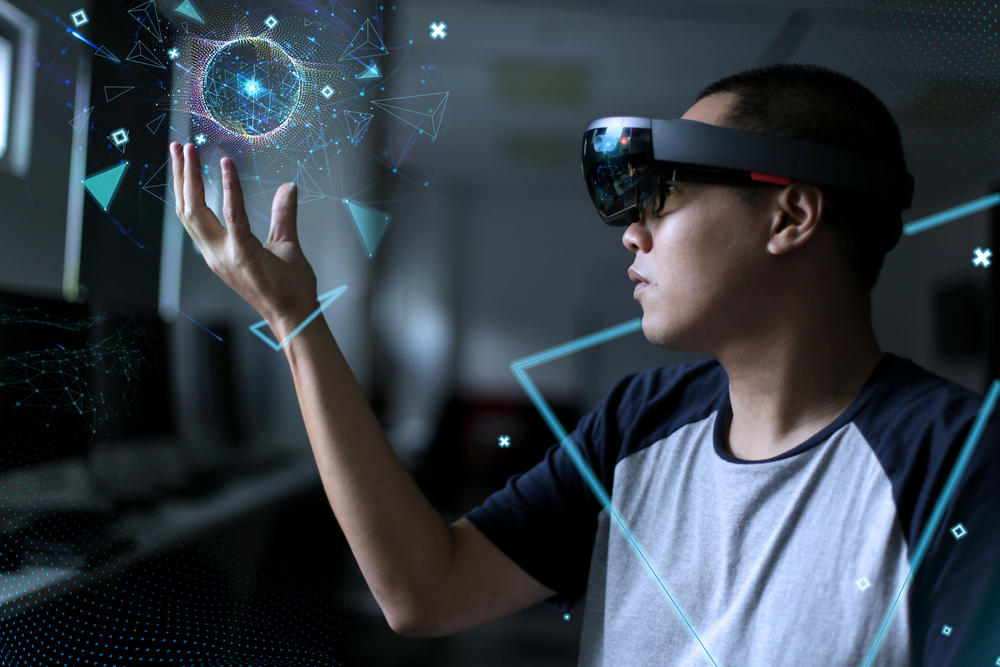Highlights:
- Marker-less augmented reality facilitates occlusion and the inclusion of virtual buttons.
- Marker-based augmented reality employs visual markers such as QR codes or tangible objects to position digital content within the physical environment.
In an era where technology is continuously reshaping our interactions with the world, augmented reality (AR) stands out as a potent force of transformation. Augmented reality (AR) adeptly fuses digital elements with our tangible reality, enriching experiences across a multitude of industries.
In the extensive realm of augmented reality, two dominant methodologies emerge: marker-based and markerless AR, each occupying a prominent position. When contrasting marker-based Vs. markerless AR, we provide unequivocal routes to integrate virtual content into the tangible environment seamlessly. Each method presents distinct advantages, meticulously suited to particular business applications.
In this exploration, we navigate the definitions, essential distinctions, and real-world case studies of marker-based and markerless AR. This endeavor aims to illuminate the most fitting choices across a spectrum of scenarios.
Marker-Based Augmented Reality
Marker-based AR stands as a prevalent form of augmented reality (AR). This kind of AR experience is linked to a marker, dictating the positioning of digital elements in accordance with the marker’s location.
Usually, the digital content appears above the marker and adjusts its position as the marker shifts or turns. In the world of marker-based AR engagements, a stationary image, typically denoted as a ‘trigger photo,’ takes center stage. Initiating the AR experience is as straightforward as employing a mobile AR app to scan this image, ushering users into a captivating digital dimension.
In simple words, the user can use their phone camera to scan the marker, triggering the appearance of the digital experience.
To gain comprehensive insight, marker-based augmented reality examples will thoroughly elucidate this technology.
A Real-world Illustration of Markerless Augmented Reality in Action
Consider a case study within the manufacturing sector focused on enhancing machinery performance and maintenance to drive productivity. It will help in below ways:
-
Maintaining dashboard
Using a tablet and specialized AR app, factory technicians access a dashboard displaying real-time data about machinery within the facility, identifying equipment that needs attention.
-
Equipment identification
The app promptly recognizes the machine by aiming the tablet’s camera at it and utilizing its identifying label as the marker. It retrieves crucial details, including maintenance history, specifications, and known issues.
-
Guided repair steps
After marker recognition, the app displays interactive markers on the equipment, indicating maintenance zones. Technicians can tap these markers for step-by-step repair instructions, safety precautions, and video tutorials.
-
Streamlined inventory handling
The app integrates with our inventory system. When technicians select replacement parts, the app confirms availability and can automatically place orders if needed, ensuring uninterrupted workflow.
Within the business arena, marker-based AR transforms equipment maintenance with real-time analytics, data-fueled insights, and impeccable compliance documentation. It fuels turbocharged efficiency, slashes downtime, and significantly boosts manufacturing productivity.
Marker-Less Augmented Reality
Markerless AR represents AR advancement without physical markers. The days of printing AR codes on stickers or posters are over. This modern method empowers marketers for seamless AR in any setting via the mobile app or web AR. Digital components blend into surroundings, even walls or floors.
In essence, digital elements adapt to the environment’s geometry, as seen in gaming like Pokémon Go. It’s favored for live events and virtual product integration.
Importantly, its versatility caters to all devices, from iPhones to Androids, bridging innovation for marketers and audience engagement. It’s also highly beneficial for marketers aiming to engage audiences through innovative and imaginative approaches.
For a comprehensive understanding, markerless augmented reality examples will provide an illuminating insight into this technology.
A Real-World Illustration of Markerless Augmented Reality in Action
Picture yourself as an ambitious retail store owner aiming to transform the shopping experience for your clients. In a thriving e-commerce era, you aim to bridge the gap between the digital and physical retail realms. Marker-less AR will help you in the below ways:
-
Enhanced shopping experience
Upon entering your store, customers are drawn to a sign inviting them to elevate their shopping journey via your store’s markerless AR app. Intrigued, they promptly download and activate the app.
-
Try before you use
Customers find a virtual fitting room, selecting outfits from racks. The app overlays these selections on their live camera view, allowing them to gauge fit and appearance beforehand.
-
Interactive product info
As customers choose a product, the app scans it via the phone’s camera. This triggers an interactive display, offering comprehensive details, reviews, and even a usage video.
-
Discovering hidden info
While customers explore your store, the app leverages markerless technology to pinpoint their location. Seamlessly, it directs them to hidden gems they might have overlooked, suggesting items aligned with their preferences and past purchases.
So, this transformative markerless AR experience converts your store into an interactive hub, seamlessly merging physical and digital shopping. Patrons leave with both products and an unforgettable tech-infused shopping memory.
Marker-Based Vs. Marker-Less AR: Which One Is Best?
Clearly, marker-based AR thrives in controlled settings with well-defined markers, while markerless AR facilitates dynamic and intuitive interaction with the real world. Let’s conduct a comprehensive comparison to determine the most suitable choice for marketers precisely:
| Marker-Based Augmented Reality | Marker-Less Augmented Reality |
|---|---|
| With accurate marker image preparation, it offers stable tracking, quality experiences, and no content shaking. | After placing content in a room, it becomes more flexible than marker-based options. |
| It uses visual markers like QR codes or physical objects to place digital content in the real world. | It frees users from markers, seamlessly integrating digital content into the environment. |
| It is supported by a camera and visual marker only. | A processor, GPS, display, camera, microphone, velocity meter, or accelerometer supports it. |
| Simple implementation, with market-available and recognized marker-based toolkits, are its advantages. | Accuracy is its most significant advantage. |
| The virtual model becomes unavailable if a portion of the marker becomes obscured. | They facilitate occlusion and the inclusion of virtual buttons. |
In summary, the selection between marker-based and markerless AR is contingent upon the aspired degree of accuracy, the imperative for adaptability, and the envisioned user experience.
Conclusion
The evaluation of marker-based Vs. markerless augmented reality highlights the dynamic realm of digital encounters. Marker-based AR, leveraging visual indicators, thrives in precision-demanding situations, ensuring stability within controlled settings. On the other hand, markerless AR offers freedom from markers, facilitating seamless incorporation into surroundings, making it ideal for immersive, intuitive interactions.
In conclusion, both methodologies intricately meld within the ever-evolving canvas of augmented reality. These versatile augmented reality technologies are levitating business and shaping our outlook and engagement with the world, ushering in an era of transformation.
Broaden your understanding of these subjects by delving into our comprehensive array of AI-focused whitepapers.





























































